CREATION WEBSITE / THEORY.
1/406
Name | Mastery | Learn | Test | Matching | Spaced |
|---|
No study sessions yet.
407 Terms
What’s the web ?
It’s the same processus than the electricity’s processus. everything is connected. linked.
W3C ?
Web Technology Standardization Organization
What’s the difference between dynamic and static page ?
The dynamic pages have programming languages,
the static not. (not using php, java) It’s using html static → vitrine
What’s a website ?
It’s a good way to communicate with our clients.
What’s a website ? from a technical point of view ?
Resources accessible on the internet and rendered in a browser.
What are the challenges of a website ?
Profitability : serve an objective → ROI
Durability must evolve with the E needs.
and Interoperability : must be integrated at the E’s system.
What’s the 4 main waterfall phases ?
1. Analysis → what’s available
2. Development → content, graphic design
3. Publication → hosting, development
4. Maintenance → updates, bug fixes
What are the risks ?
-> costs, deadlines, quality
-> dissatisfaction from customers
-> bugs, cybersecurity, …
What’s the 4 things we have to really apply ?
1. Define what the client actually want.
2. Find an efficient design and responsive
3. Quality and engaging content
4. Care about SEO
Why create a site if users can't find the info they need, leave early due to unclear structure, or don't visit at all?
Importance of site usability, create sub-menus enhance visibility and make research easier for the client.
What could the client go until buying on my website ?
-> customer journey
Always … ?
UX before UI.
Conversion ?
the client want that his visitors stay on his website more than 2min.
CONTENT?
it has to target the right person with the right message.
The 5 W’s ?
● Who : audience
● Why : justification
● What : definition of the message
● Where : choice of broadcast format and channel.
● When : publications planning.
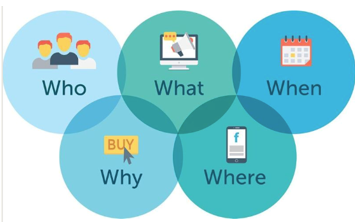
4 types of schemas to read on a website ?
● F type
● Tâcheté
● Par couches
● Engagé
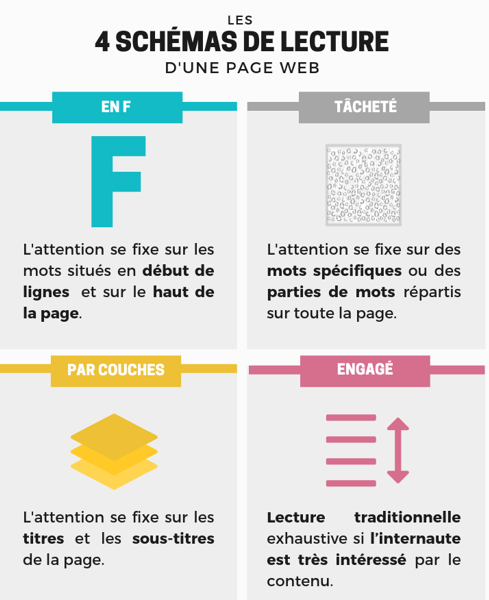
Content spinning ?
Its creating different versions of content by reorganising or replacing words, sentences or paragraphs, while retaining the same general meaning.
SEO well ranked of a website ?
Is a website who has more then 2000 words innit.
UGC ?
User generated content : influencers/customers that recommend products of a brand.
It can also give sometimes bad recommendations on the products. The E can’t control that.
YMYL ?
Your Money Or Your Life. → content that has a significant impact on the health, safety, finances, and therefore requires greater reliability, expertise and credibility.
Webmaster ?
c’est un professionnel indépendant ou en interne au sein d'une entreprise, qui possède des compétences techniques pour concevoir, développer et gérer un site web.
What’s inbound marketing?
its a strategy used by companies that involves delivering useful, high-quality content, to attract prospects / customers.
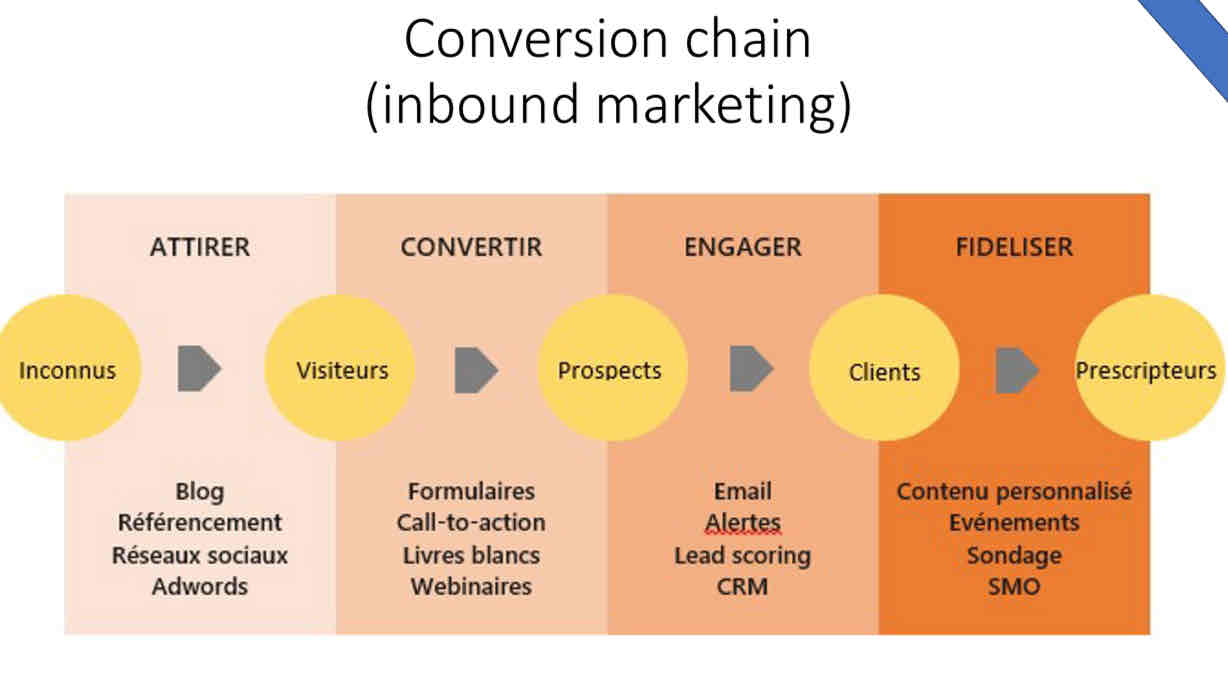
What are the 4 stages of the conversion chain ?
attract, convert, engage and retain.
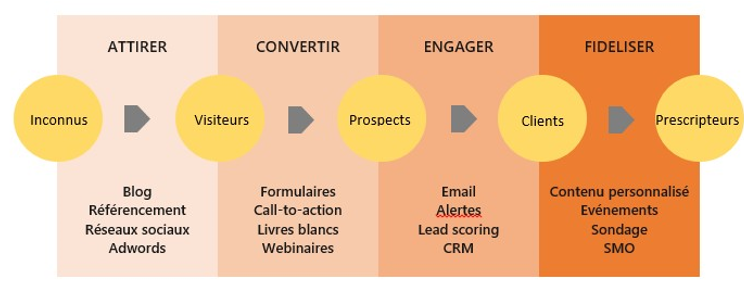
Attract potential customers ?
prioritise quality over quantity by attracting visitors who are likely to become customers.
Convert visitors into leads ?
the aim is to obtain the customer's contact details.
Turning prospects into customers ?
it’s to maintain the relationship between the visitor and the website. Offer them relevant and appropriate content to turn them into customers.
Turn customers into true ambassadors ?
even as a customer, you need to continue to offer quality content. The aim is to turn them into brand ambassadors.
RACE Framework ?
Reach: Strengthening current brand awareness.
Act: Encourage the prospect to interact (browse the catalogue, sign up for the newsletter, etc.).
Convert: Persuade the prospect to convert.
Engage: Establish a long-term relationship to encourage repeat purchases.
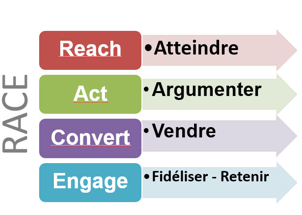
AIDA method ?
Attention: attracting attention → Adapted visual
Interest: Attracting interest → Relevant information
Desire: arousing desire
Action: sparking action → Business offers
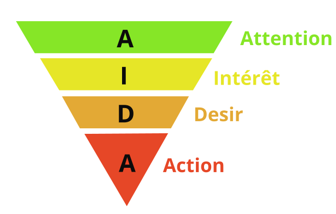
Main objectives of an article ?
Attract :
Attract visitors via SEO.
Spark their interest.
Expertise = TRUST.
Convert :
Invite visitors to visit other pages on the site via internal links.
Each page is an opportunity to invite visitors to browse the site.
Examples of contact strategies ?
gym : geographical location is essential.
→ focus on the map, show on the map how many gyms there are.
Legal content ?
RGPD
Legal info
General terms & conditions of sale
Terms & conditions of purchase
Organic traffic ?
Traffic generated when users find and click on a link from a search engine.
Referral traffic ?
Traffic generated when users click on a link (backlink) from another website (blog, partner site, online directory, social networks, etc.).
SE ?
online tool that allows users to find information on the web by entering a search query.
What’s the 3 phases of SE ?
Crawling
Indexing
Ranking
Indexing ?
The data collected is sorted and recorded. The OS identifies the content and assesses the quality of each page.
Ranking ?
Based on user requests, the OS determines a page ranking (the famous "algorithm").
SERP ?
-> Search engine results page :
Search options
•Search terms
•Types of content (images, etc.)
•Filters (e.g. location)
•Estimated number of results
•Ordered list of results
•Sponsored sites
•Referenced sites
•Additional information (map, etc)
•Search suggestions
The ranking ?
-> Search refinement based on the use.
Organic vs. sponsored results ?
Organic is not payed and sponsored is payed.
SEO vs SEA ?
SEO imrove natural search results, SEA advertise the campaign for appearing in the first search results.
Web promotion ?
→ social networks, google my business
What’s the pros and cons of natural referencing ?
Pros : Natural search is better for constant traffic, good SEO is free and increases traffic in the long term.
Cons : takes time & constant optimisation.
Requires investment in quality and there’re no guarantee of results.
How can we list ?
-> SEO strategy
-> SEO optimisation
SEO pyramid ?
→ it illustrates the hierarchy of key components for
→ each layer builds upon the previous one.
On/off page criteria ?
On page : improve quality of your site for users and SEs.
Off page : Improve your site's visibility and online reputation.
Link building ?
-> it's about getting other websites to link to yours.
Black hat SEO ?
Principle : Penalised by the SE !
-> by Keyword stuffing: Overloading the content with keywords.
Spamdexing ?
Creation of artificial backlinks to quickly boost PR.
SEM Glossary ?
-> Positioning (average position).
•Impressions.
•Clicks.
•Click-through rate (CTR)..
•Bounce rate.
•Time spent on page
•Returning visitors.
Positioning (average position) ?
Average ranking in search results.
Impressions ?
Number of times a page appears in search results.
Clicks ?
Number of times users have clicked on your link.
Click-through rate (CTR) ?
Percentage of clicks compared to impressions
Bounce rate ?
Percentage of users who leave your site after viewing a single page.
Time spent on page ?
Average time users spend on a page.
Returning visitors ?
Users who return to your site after having already been there.
Page rank ?
the more quality links a site receives from other websites, the higher its PageRank.
Development trend ?
-> page rank : popularity of info
-> Rankbrain, BERT : understanding info.
Crawling ?
Its a program that automatically explores websites (crawling phase).
To crawl a site, a bot’ll use wich tools ?
A bot will use several tools:
•robots.txt
•sitemap.xml
•Internal linking
•Meta robots tag
•Rel attributes
Robots.txt ?
-> its a text file used by convention to prevent crawlers from accessing all or part of a website.
Internal Linking ?
Navigation using internal links.
Website hosting ?
→ service that enables individuals to make their websites accessible on the web by providing storage for websties files and technology to display them.
Shared hosting ?
→ multiple websites that share the same server ressources, typically at a lower cost.
Dedicated hosting ?
→ single website has access to an entire server, → more control & performance
Virtual Private Server (VPS) ?
→ single server divided into virtual servers offering personal software space with some resource guarantees
What’s a website from a practical point of view ?
It’s a means of communication → a medium
What’s a medium ?
It’s conjuctural, the info is structural. → We cannot think of one without the other !
Website création involves … ?
Planning, designing, developing, putting online and maintaining a functional site aimed at reaching its target audience.
What’s creating a website at the start ?
creation of a new site (from scratch)
Redesign of an existing site
Development of an existing site
Projet management ?
incitation
Planning
Exécution
Control
Closure
What’s the three fundamental constraints in a project ?
Efficience : élimination de toute source de gaspillage
Qualité
Réactivité : vitesse du système par rapport à la demande
Coût
Agilité : vitesse du système sur l’adaptation de sa structure coût et services
Délai
Efficience : élimination de toute source de gaspillage
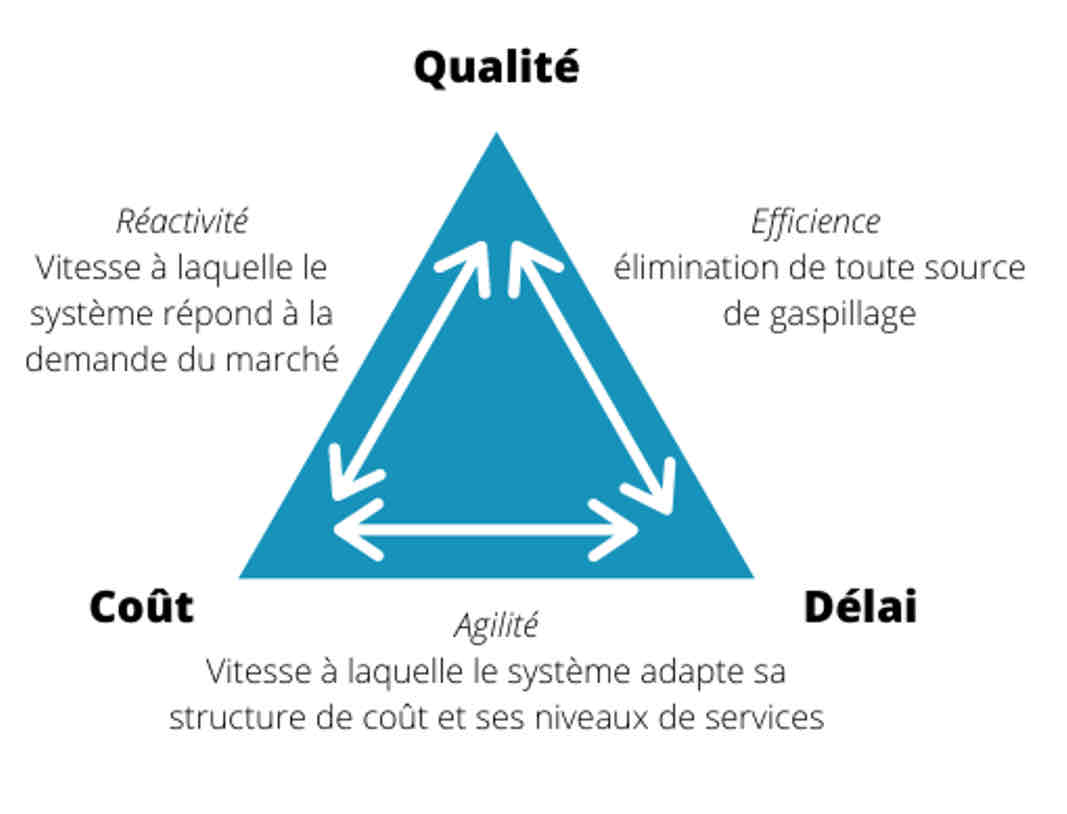
Persona journey ?
Schematic representation of a typical user journey though a product / service
What’s the benefits of a website ?
visualisation of the stages of interaction with the site.
Detection of friction points
Prioritising functionalities
UX optimisation
Business cas vs. Objectives ?
Business case → why.
measured by an ROI
Objectives → how.
objectives are the consequences of the business case.
measured by KPI’s
How can we attract customers in the inbound marketing ?
We can by creating a blog, use a SEO, use social medias, and AdWords.
How can we convert customers in the inbound marketing ?
We can by creating forms, CTA buttons, livres blancs, webinaires
How can we engage customers in the inbound marketing ?
email, alerts, lead scoring, CRM
How can we retain customers in the inbound marketing ?
Customized content, events, sondages, SMO
What’s the first 2 messages to convert ?
Who ?
Who are we ?
What’s our identity, raison d’être ?
What ?
What can I do here ?
What main action’ll the user perform ?
An interesting content is … ?
Essential for referencing.
Useful information ?
Enriches the visitor experience.
Assertive expertise ?
Builds trust and credibility.
Audience engagement ?
Builds loyalty and encourages interaction.
SEO enhancement ?
Increases online visibility.
Organic traffic ?
Generates sustainable traffic.
Targeted conversion ?
Promotes the desired actions.
Sharing experiences ?
Creates an emotional connection
Engaged community ?
Build a loyal fan base.
What’s the main objectives of an article ?
attract
Visitors via SEO
Spark their interest
Expertise → trust
Convert
Invite visitors to visit others pages via internal links
Each pages is an opportunity to browse the site
Favicons technical specifications ?
The same site offers several files, depending on the browser and device.
SEM ?
SEO + SEA (+SMO)
Google ranking criteria ?
• Domain name for exact keywords
• Fresh search results
• Useful content
• Link analysis and PageRank
• Local news
• Original content
• Deduplication prevention
• Reliability of information
• Opinion
• Diversity of sites
• Spam detection
What’s a crawler ?
It’s a program that automatically explores websites.
Siloing ?
Organisation of content into distinct thematic sections
Link juice ?
Authority transmitted by links from one page to another
PageRank Sculpting ?
Optimising the distribution of internal link juice by using no follow links in particular.
Meta robots tag ?
(<meta name = “robots” content = “index, follow”>
It’s used to address the indexing robots to index page, indicate how often the page is refreshed and choose or not to follow the links on the page.